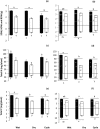Interactive effects of compost and pre-planting soil moisture on plant biomass, nutrition and formation of mycorrhizas: a context dependent response
- PMID: 29367677
- PMCID: PMC5784012
- DOI: 10.1038/s41598-017-18780-2
Interactive effects of compost and pre-planting soil moisture on plant biomass, nutrition and formation of mycorrhizas: a context dependent response
Abstract
We aimed to investigate the combined impacts of compost addition and pre-planting soil moisture conditions, on plant-available nutrients, and subsequent impacts on the biomass, nutrition and formation of AM by two important crop species. A glasshouse study was undertaken in which wheat and tomato plants were grown in compost amended or un-amended soil that was subjected to different moisture regimes prior to planting. The availability of P was strongly influenced by compost addition, but not pre-planting moisture conditions. In contrast, mineral N pools were affected by compost addition and pre-planting soil moisture conditions in complex ways. These changes in nutrient availability affected plant biomass, nutrient uptake and formation of AM. In general, plant performance was better where pre-planting soil moisture conditions were wet or dry, and worse where they involved a wet/dry cycle, and mycorrhizal colonisation was lower where compost was added to the soil. That pre-planting moisture conditions affect the biomass of subsequent crops is an important finding, the potential implications of which are considered here.
Conflict of interest statement
The authors declare that they have no competing interests.
Figures




References
-
- Mikha MM, Rice CW, Milliken GA. Carbon and nitrogen mineralization as affected by drying and wetting cycles. Soil Biol. Biochem. 2005;37:339–347. doi: 10.1016/j.soilbio.2004.08.003. - DOI
-
- Borken W, Matzner E. Reappraisal of drying and wetting effects on C and N mineralization and fluxes in soils. Globe. Change Biol. 2009;15:808–824. doi: 10.1111/j.1365-2486.2008.01681.x. - DOI
-
- Seneviratne SI, et al. Investigating soil moisture–climate interactions in a changing climate: a review. Earth-Sci. Rev. 2010;99:125–161. doi: 10.1016/j.earscirev.2010.02.004. - DOI
-
- Kaiser M, Kleber M, Berhe AA. How air-drying and rewetting modify soil organic matter characteristics: An assessment to improve data interpretation and inference. Soil Biol. Biochem. 2015;80:324–340. doi: 10.1016/j.soilbio.2014.10.018. - DOI
-
- Warren CR. Response of osmolytes in soil to drying and rewetting. Soil Biol. Biochem. 2014;70:22–32. doi: 10.1016/j.soilbio.2013.12.008. - DOI
Publication types
MeSH terms
Substances
LinkOut - more resources
Full Text Sources
Other Literature Sources

